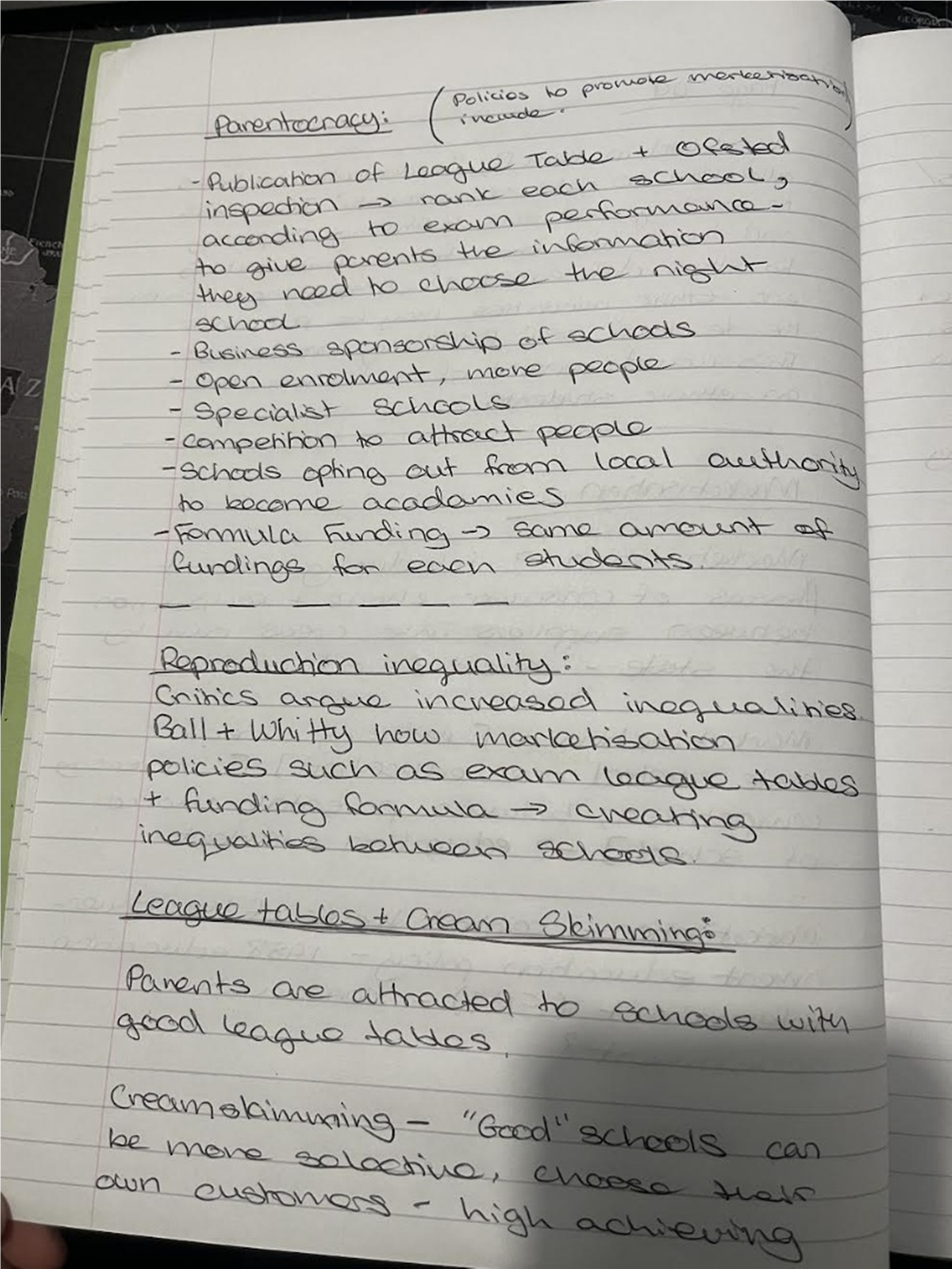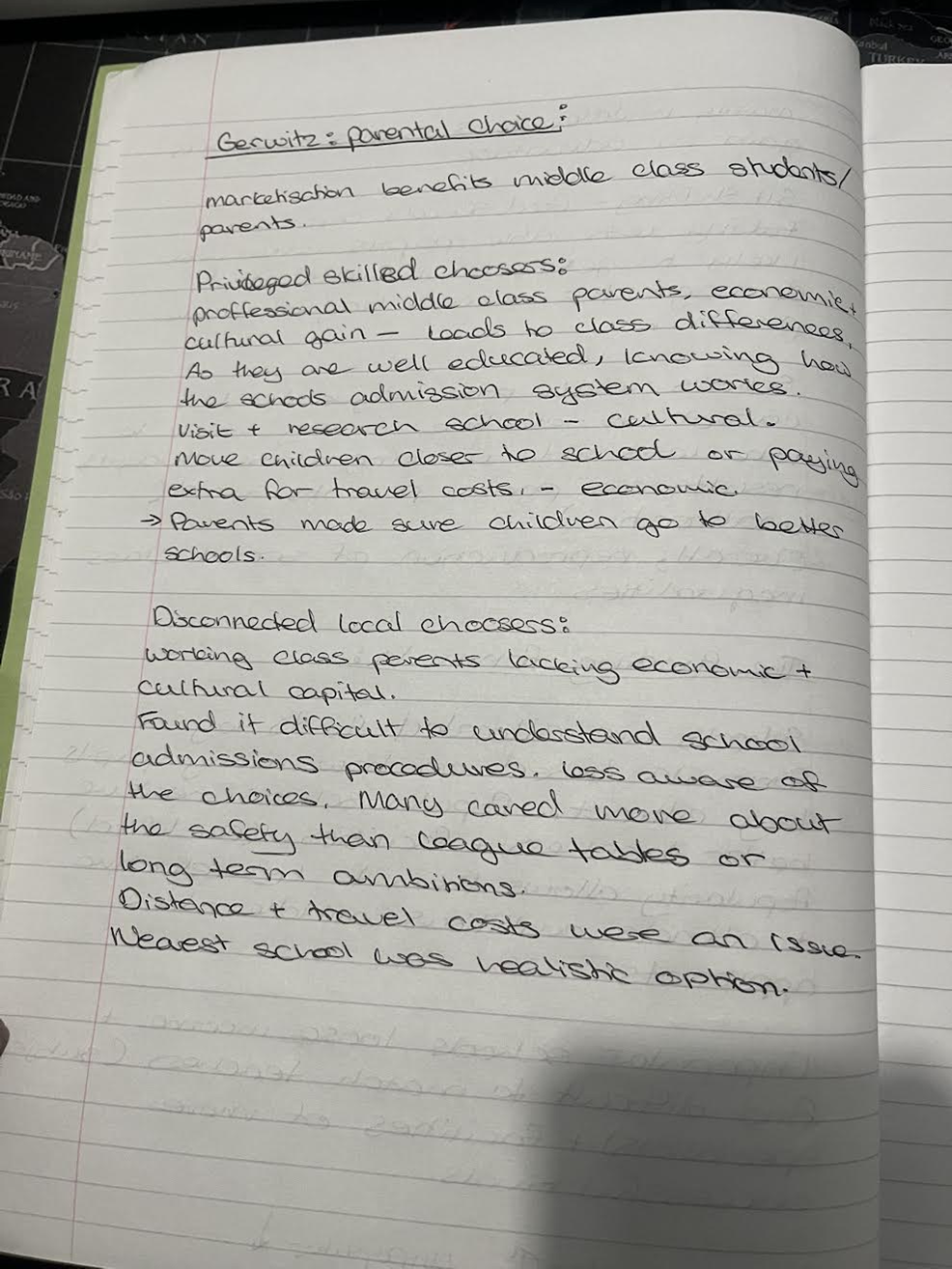Educational Policy
1/12
Earn XP
Description and Tags
Name | Mastery | Learn | Test | Matching | Spaced |
|---|
No study sessions yet.
13 Terms
Educational policy
how and why schools operate, picking and selecting students. Getting students to come to the school.
Tripartite system
a selection process. Children should get their status through achievement and not ascribed. Children should work hard to get to where they want to get to. The 11-plus was created. This is for children being sifted and shifted into either a grammar school, however, if they fail or they don’t sit the test, they would be put into a normal state school. This would mean the people at the grammar would have more educational achievement therefore they would be able to get into the non-manual jobs. However, for the people that do not go to the grammar school they are expected to do the manual jobs. This reproduces class inequality, by the that middle class has a greater advantage to lower class, as middle class can spend enough money on their children for private tutor, whereas a lower-class parent may not be able to put the money in therefore it reproduces class inequality. It is legitimised due to the ideological state apparatus, this would mean that they think they deserve to be there. (link to Althusser)
Functionalists argue that it promotes social integration (coming together) bringing children of different social classes into one school. (one word meritocratic)
Comprehensive state school is when children go to school in their area, this tackles the class divide, don’t have to sit an exam, any kid can go.
Evaluation - Ford found out that there was little social mixing between middle class and lower class which means this system was not effective. As the rich would stay with the rich and the poor would stay with the poor. It was trying to get rid of the segregation but there still is the segregation.
Marxists focuses in the internal factors, as the school is not meritocratic. As they continue to stream and label the children.
Marketisation:
Introducing market forces of consumer choice + competition between suppliers in areas run by the state – such as education.
Marketisation= [reducing direct state control over education] [increasing competition, between parental choice of school] – education market.
Marketisation – ventral theme of the government education policy- 1988 education reform act (ERA) – conservative gov?
It increases parental choice and increases competition with surrounding schools. Publishing of league tables, Bursaries, Scholarships, Specialist schools.
Parentocracy:
David says parentocracy, the idea that the parents are now the concern. More money through funding government.
League tables and cream skimming
Ball
Silk shifting and cream skimming – Schools have a policy of posting the league tables (examination results) The schools that achieve good results are more in demand, because parents are attracted to those school who have the higher results, so the good schools more scope to pick out students, they can pick high achieving middle class pupils which is call cream skimming, and the good schools are able to not take in lower achieving students, so that they won’t damage the schools league table position, this is called silt shifting.
Funding Formula:
Schools are allocated funds by a formula based on how many pupils they attract. Popular schools get more funds and can afford, better qualified teachers, better equipment this means that the school becomes more attractive for the parents which means they want their children to study there. With the unpopular schools, the schools are smaller and they do not have as much funding as the popular school. For this the schools have inadequate equipment, fewer teachers, this means when the parents see this they would not want their children to come to this school.
Parental Choice:
Gewirtz
Increased parental choice advantages middle class parents and disadvantages lower class parents as they lack cultural capital. She identifies 3 main types of parents
1. Privileged skilled choosers are middle class parents, they have the right cultural capital, they are well educated, and understand the value of education, they know how the school admission system works, they know which schools are good or bad, and they also have connections, they also have economic capital (how much money they got) they can move their children around the education system to get the best of it. If a good school is far away they can pay for the child’s transportation, they can also move their child to a nearer house.
2. Disconnected local choosers, they lack both economic and cultural capital (lacking knowledge and money), they are not educated therefore they do not understand the value of education, they do not know how the schools admission system works, they do not know which schools are good or bad, they do not have any connections, they don’t have economic capital, they cannot pay for transport as it is too expensive or even go to the extent of moving house, therefore they look for the schools nearby instead of the schools that are far.
3. Semi skilled choosers, they are still working class parents, however they are more ambitious for their children, so they lack cultural capital they still found it difficult to navigate to they have to rely on other peoples opinions about schools.
This reproduces class inequality as the two different schools, this is by the middle class parents choosing the good schools and the working class choosing the bad schools, so the children would be in two different schools, proving class inequality.
Myth of parentocracy:
It makes it seem like parents have a choice, realistically not all parents have a choice, some have more information and knowledge about schools than other parents, so parental choice created inequalities.
Privatisation:
Schools used to be a public thing, now it is a private thing. So it is the transfer between the public asset, which is the school, to private companies. Private companies in the ESI (education services industry) are increasing activities in education, more supply teachers, more work-based learning, more career advice and Ofsted inspection services. Private companies.
The cola-isation of schools:
The private sector (companies) penetrate education indirectly, this can be through vending machines on school premises, the development of brand loyalty, through displays of logos and sponsorships.
Example: Radnor as a company. Schools are targeted by these private companies because schools have a good reputation and are associated with good will. They will confer legitimacy, with anything associated with them. So they would promote things that are not good or healthy, so they are very particular.
Education as a commodity:
Explaining what privatisation is, by the sociologist Ball. Privatisation is the key factor of shaping educational policy. Schools becoming a private company rather than a public asset institution. Policies move schools from public to private. States and governments are losing control over the schools.
Marxists say that they are being handed to private capitalists, so they make it seem like the privatisation is a good thing. However, it makes it seem like they are driving up the standards of the school, but it is js private profits.


